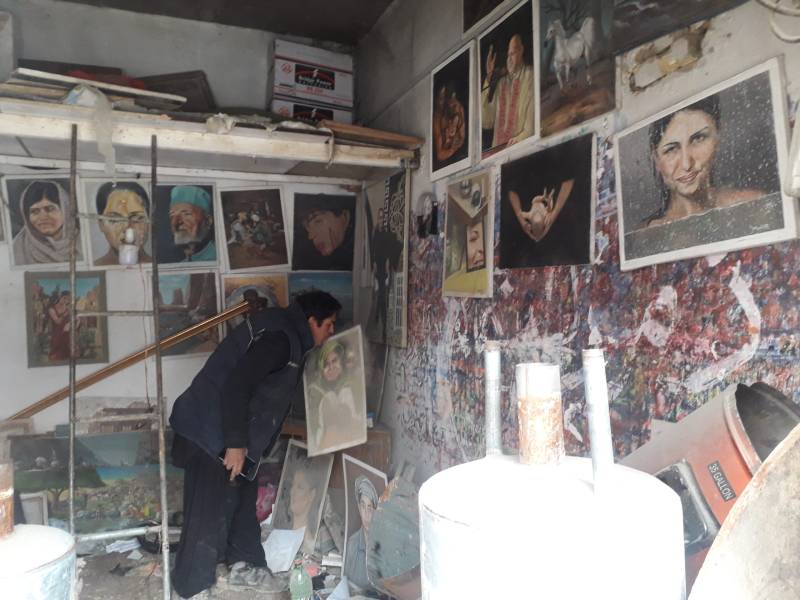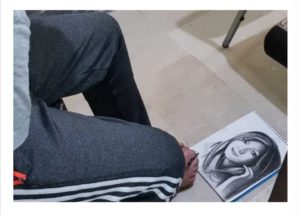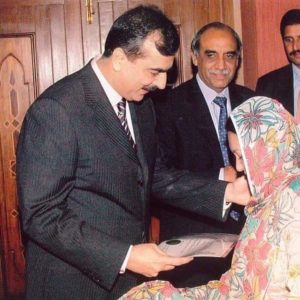
Keeping a piece of paper in front of him and tightly holding the sketching tools with his little toes, 14-year-old Ali Gohar begins to sketch an image with his feet.
The young artist from Alamdar Road, Quetta was 9-year-old when he flied kite, but one fateful day, thunderstorm disabled his two hands forever. “I used to see people draw and paint, and was hurt that I could not do it, but I tried to paint with my toes – and it worked”, he says.

Ali aspires to be a well-known artist one day, and vows not to let his disability affect his goals in life. He urged the government to support the artists and facilitate them.
Another differently-abled artist Shazia Batool is defying the odds to pursue her career as an artist.
She was only three-year-old when a wrong injection disabled her legs, but she did not let this tragedy turn into a hurdle. She has a Bachelor’s degree in arts from the Fine Arts Department at the University of Balochistan, and completed her Master’s degree from the College of Arts and Design. Currently, she is a professional artist and designer at the Pakistan Television (PTV) Quetta Center.

Shazia was recently awarded the Tamgha-e-Imtiaz and is also a recipient of the United Nations Women Award. She has 21 awards to her name.
Talking to Naya Daur, she lamented that artists are not given due respect in Pakistan. “Neither in Pakistan, nor in Balochistan are the arts given the respect they deserve." She urged the government to create employment opportunities for the artists.
Meanwhile, Quetta's renowned artist Muhammad Munir, though not disabled the way Shazia and Ali, is on the verge of losing his eye sight. He works as a welder in Quetta because he did not find any opportunities where he could utilize his artistic skills.

He uses a part of the shop he's rented for painting, but remains focused on welding as it is his source of income. The welding work has affected his eye sight. Munir says he was once a celebrated artist, but he had to quit painting because it did not give him any financial benefit.
Syed Mubbarak Shah, a lecturer at Fine Arts Department University of Balochistan, agrees with Munir. "Our people cannot even differentiate between a scenery and an art piece,” he says, and explains that a scenery can be copied in thousands while the art piece is the lone one you have in hand. Even our government officials who are responsible for patronage of arts and culture cannot differentiate between them,” he says.
The young artist from Alamdar Road, Quetta was 9-year-old when he flied kite, but one fateful day, thunderstorm disabled his two hands forever. “I used to see people draw and paint, and was hurt that I could not do it, but I tried to paint with my toes – and it worked”, he says.

Ali aspires to be a well-known artist one day, and vows not to let his disability affect his goals in life. He urged the government to support the artists and facilitate them.
Another differently-abled artist Shazia Batool is defying the odds to pursue her career as an artist.
She was only three-year-old when a wrong injection disabled her legs, but she did not let this tragedy turn into a hurdle. She has a Bachelor’s degree in arts from the Fine Arts Department at the University of Balochistan, and completed her Master’s degree from the College of Arts and Design. Currently, she is a professional artist and designer at the Pakistan Television (PTV) Quetta Center.

Shazia receives the award from former Prime Minister Yousuf Raza Gilani
Shazia was recently awarded the Tamgha-e-Imtiaz and is also a recipient of the United Nations Women Award. She has 21 awards to her name.
Talking to Naya Daur, she lamented that artists are not given due respect in Pakistan. “Neither in Pakistan, nor in Balochistan are the arts given the respect they deserve." She urged the government to create employment opportunities for the artists.
Meanwhile, Quetta's renowned artist Muhammad Munir, though not disabled the way Shazia and Ali, is on the verge of losing his eye sight. He works as a welder in Quetta because he did not find any opportunities where he could utilize his artistic skills.

He uses a part of the shop he's rented for painting, but remains focused on welding as it is his source of income. The welding work has affected his eye sight. Munir says he was once a celebrated artist, but he had to quit painting because it did not give him any financial benefit.
Syed Mubbarak Shah, a lecturer at Fine Arts Department University of Balochistan, agrees with Munir. "Our people cannot even differentiate between a scenery and an art piece,” he says, and explains that a scenery can be copied in thousands while the art piece is the lone one you have in hand. Even our government officials who are responsible for patronage of arts and culture cannot differentiate between them,” he says.
